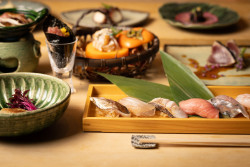
Originally published on metropolis.co.jp on November 2011

In the early 20th century, famous potter Shoji Hamada set up a kiln in the town of Mashiko in Tochigi prefecture, attracted by the quality of local clay and the rustic beauty of the pieces produced there. Through his promotion of the folk art movement and support of young artists, Hamada attracted hundreds of potters to the little town and made it an internationally known center for both quotidian and artistic ceramics.
On March 11, however, the future of Mashiko pottery was thrown into doubt by the upheaval from the Great East Japan Earthquake. Potter Ken Matsuzaki, owner of the pottery workshop Yuushin-Gama says, “Mashiko regularly has small earthquakes around three on the Japanese scale, and the earthquake on March 11th started out like that, but eventually the tremors got more severe, supports were unable to stand, and all of the ceramics on the shelves and the dishes in the cupboards came flying out. Even the roof tiles were falling like they were jumping off.”
The potters in Mashiko use traditional climbing kilns known as noborigama, which consist of several chambers built on an incline to make efficient use of the heat. The kilns, along with the unique clay and glazes used there, are part of what defines mashikoyaki, or Mashiko ceramics. There had been about 50 of the kilns in the town, but the fierce shaking completely destroyed 90 percent of them. “For a city that survives and thrives on pottery making, it is as if the fire in our hearts has been extinguished,” says Matsuzaki.
There was also the loss of a large chunk of Mashiko’s history in the form of the artwork destroyed, particularly that of Hamada, which was housed in the Mashiko Reference Collection Museum. The buildings, which include Hamada’s kiln and the home he lived in, are on the verge of collapse. Matsuzaki estimates the damage to the museum at ¥80 million, but even if the buildings can be restored over time, many of the pieces have been shattered beyond repair.

If there is a bright side to this story, it is in the quick and emphatic response from supporters here in Japan and abroad. In the aftermath of the disaster, friends from all over the world reached out to Matsuzaki through email and Facebook with messages of support and inquiries about where to send donations. After consulting with the mayor, an NPO called Mashiko Pottery Fund was set up to assist rebuilding efforts and has so far collected about ¥13 million.
“A few of my English potter friends called upon the many potters they know, pieces were donated and sold at auction at Leach Pottery, and the proceeds were donated to MPF. In Boston, the owner of a gallery where I am doing a one-man show appealed to his customers and was able to collect a large amount of donations,” says Matsuzaki. “I was impressed by the overseas support that we received, and am deeply moved and filled with gratitude.”
Here in Tokyo, the Mashiko-born president of Otsuka Corporation set aside ¥50 million for the reconstruction of kilns, out of an overall ¥200 million donated to the city for the development of Mashiko pottery. However, even with this support coming in, Matsuzaki warns that the process will be slow. There are very few artisans trained in the construction of noborigama kilns, so it could be more than two years before the original 50 are back up and running.
In the meantime, the potters of Mashiko are doing their best to keep their traditional art alive by taking Mashiko to the world. A project to broadcast scenes of the artists at work, the firing process, and the galleries to the world in real time using hand-held 4G devices is under consideration, as well as exhibitions at overseas galleries.
Matsuzaki worries that the disruption to work could be disastrous for the future of Mashiko pottery, turning the city from a center of artistic production to a mere tourist attraction, but he’s not giving up hope either. “Whatever we do, I would like to move forward from the current feeling in Japan that things are at a standstill, and somehow get moving towards the future.”
To make a donation, see http://meturl.com/mashiko. For more info on Ken Matsuzaki and Yuushin-Gama, see www.yuushin-gama.com.







